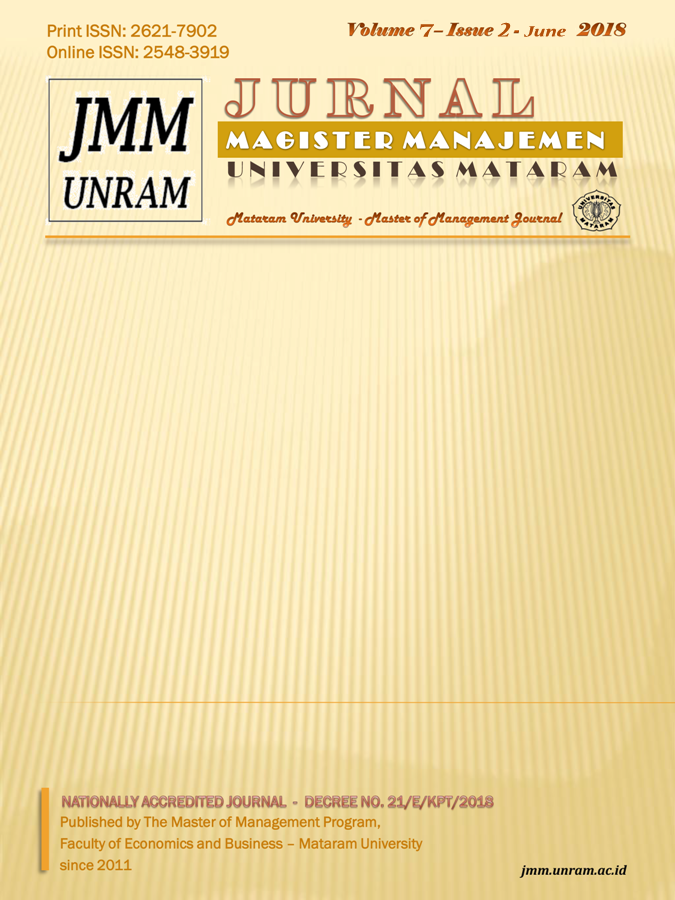PERUMUSAN STRATEGI DINAS PARIWISATA DAN KEBUDAYAN KABUPATEN LOMBOK TENGAH UNTUK MENINGKATKAN KUNJUNGAN WISATAWAN DI PANTAI SELATAN LOMBOK TENGAH
DOI:
https://doi.org/10.29303/jmm.v7i2.381Abstract
This study aimed at formulating the strategy proposed to the District Agency of Tourism and Culture of Central Lombok to increase tourist visits. This research is using a qualitative approach within case studies. Informants were selected through purposive sampling. Two informants were selected from the Agency of Tourism and Culture of Central Lombok; namely the Head of Agency and the Field Head of Marketing and Promotion. The research showed that the findings obtained from the analysis using SWOT and data reduction, the tourism in the south coast of Central Lombok has good strength and opportunity. The research recommends that in increasing numbers tourist visits the Agency of Tourism and Culture of Central Lombok conduct four better strategies namely forward integration (increasing control of tourist suppliers), market penetration (intensive promotion), concentric diversification (add tourism products such as water sports, traditional restaurants, hotels), and product development (current products modification). Since there were still problems in Human Resource, the Agency of Tourism and Culture of Central Lombok should pay more attention to human resources by developing human resource products.Penelitian ini bertujuan untuk merumuskan usulan strategi bagi Dinas Pariwisata dan Kebudayaan Lombok Tengah untuk meningkatkan kunjungan wisatawan. Penelitian ini dilakukan menggunakan pendekatan kualitatif dengan menggunakan studi kasus. Informan dipilih melalui purposive sampling. Dua informan dipilih dari Dinas Pariwisata dan Kebudayaan Lombok Tengah yaitu Kepala Dinas dan Kepala Bidang Pemasaran dan Promosi. Dari temuan penelitian yang telah dianalisa menggunakan alat analisis SWOT kemudian melakukan reduksi data, penelitian menunjukkan bahwa secara umum, pariwisata di kawasan pantai selatan Lombok Tengah memiliki kekuatan dan peluang yang cukup besar, dan penelitian merekomendasikan dalam usaha meningkatkan angka kunjungan wisatawan, Dinas Pariwisata dan Kebudayaan Lombok Tengah sebaiknya melakukan empat strategi yaitu Integrasi ke depan (meningkatkan kendali atas pemasok wisatawan), Penetrasi pasar (melakukan promosi dengan gencar), Diversifikasi Konsentrik (menambah produk-produk wisata seperti olah raga air, restoran khas, hotel), dan Pengembangan Produk (modifikasi produk saat ini). Selanjutnya karena masih terdapat masalah pada SDM, Dinas Pariwisata dan Kebudayaan Lombok Tengah harus memberi perhatian lebih terhadap sumber daya manusia dengan melakukan pengembangan produk SDMKeywords :SWOT Analysis, Strategy Formulation, Strategic management, TourismDownloads
Published
2018-06-14
How to Cite
Khairunnisa, K., Rinuastuti, B. H., & Furkan, L. M. (2018). PERUMUSAN STRATEGI DINAS PARIWISATA DAN KEBUDAYAN KABUPATEN LOMBOK TENGAH UNTUK MENINGKATKAN KUNJUNGAN WISATAWAN DI PANTAI SELATAN LOMBOK TENGAH. Jurnal Magister Manajemen, 7(2), 50–59. https://doi.org/10.29303/jmm.v7i2.381
Issue
Section
Articles
License
- Authors retain copyright and grant the journal right of first publication with the work simultaneously licensed under a CC BY-SA 4.0 (Creative Commons Attribution-ShareAlike 4.0 International). This license allows authors to use all articles, data sets, graphics, and appendices in data mining applications, search engines, web sites, blogs, and other platforms by providing an appropriate reference. The journal allows the author(s) to hold the copyright without restrictions and will retain publishing rights without restrictions.
- Authors are able to enter into separate, additional contractual arrangements for the non-exclusive distribution of the journal's published version of the work (e.g., post it to an institutional repository or publish it in a book), with an acknowledgment of its initial publication in JMM.
- Authors are permitted and encouraged to post their work online (e.g., in institutional repositories or on their website) prior to and during the submission process, as it can lead to productive exchanges, as well as earlier and greater citation of published work (See The Effect of Open Access).










